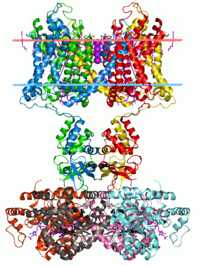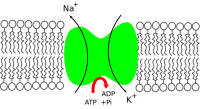
Non-Canonical Interactions between Voltage Sensors and Pore Domain in Shaker K+-Channel
Sign Up to like & getrecommendations! Published in 2017 at "Biophysical Journal"
DOI: 10.1016/j.bpj.2016.11.892
Abstract: W434F mutation in the pore domain (PD) of Shaker K+-channels yields non-conductive channels, useful for gating currents studies. Comparisons of Q-Vs recorded with W434F with those recorded with absence of K+ show virtually indistinguishable data.… read more here.
Keywords: shaker; non canonical; pore domain; domain shaker ... See more keywords

Regulation of two-pore-domain potassium TREK channels and their involvement in pain perception and migraine
Sign Up to like & getrecommendations! Published in 2022 at "Neuroscience Letters"
DOI: 10.1016/j.neulet.2022.136494
Abstract: The ability to sense pain signals is closely linked to the activity of ion channels expressed in nociceptors, the first neurons that transduce noxious stimuli into pain. Among these ion channel, TREK1, TREK2 and TRAAK… read more here.
Keywords: pain; two pore; pore domain; domain potassium ... See more keywords

Expression and localisation of two-pore domain (K2P) background leak potassium ion channels in the mouse retina
Sign Up to like & getrecommendations! Published in 2017 at "Scientific Reports"
DOI: 10.1038/srep46085
Abstract: Two-pore domain (K2P) potassium channels perform essential roles in neuronal function. These channels produce background leak type potassium currents that act to regulate resting membrane potential and levels of cellular excitability. 15 different K2P channels… read more here.
Keywords: potassium; k2p; k2p channels; two pore ... See more keywords

Tandem pore domain acid-sensitive K channel 3 (TASK-3) regulates visual sensitivity in healthy and aging retina
Sign Up to like & getrecommendations! Published in 2022 at "Science Advances"
DOI: 10.1126/sciadv.abn8785
Abstract: Retinal ganglion cells (RGCs) not only collect but also integrate visual signals and send them from the retina to the brain. The mechanisms underlying the RGC integration of synaptic activity within retinal circuits have not… read more here.
Keywords: sensitivity; tandem pore; task; pore domain ... See more keywords

The two-pore domain potassium channel TREK-1 mediates cardiac fibrosis and diastolic dysfunction
Sign Up to like & getrecommendations! Published in 2018 at "Journal of Clinical Investigation"
DOI: 10.1172/jci95945
Abstract: Cardiac two-pore domain potassium channels (K2P) exist in organisms from Drosophila to humans; however, their role in cardiac function is not known. We identified a K2P gene, CG8713 (sandman), in a Drosophila genetic screen and… read more here.
Keywords: dysfunction; two pore; pore domain; domain potassium ... See more keywords

Development of a Novel Cell-Based Assay System for High-Throughput Screening of Compounds Acting on Background Two-Pore Domain K+ Channels
Sign Up to like & getrecommendations! Published in 2019 at "SLAS Discovery"
DOI: 10.1177/2472555219829745
Abstract: Two-pore domain K+ (K2P) channels are thought to be druggable targets. However, only a few agents specific for K2P channels have been identified, presumably due to the lack of an efficient screening system. To develop… read more here.
Keywords: system; throughput screening; two pore; pore domain ... See more keywords

Development of Non-opioid Analgesics Targeting Two-pore Domain Potassium Channels.
Sign Up to like & getrecommendations! Published in 2021 at "Current neuropharmacology"
DOI: 10.2174/1570159x19666210407152528
Abstract: Two-pore domain potassium (K2P) channels are a diverse family of potassium channels. K2P channels generate background leak potassium currents to regulate cellular excitability and are thereby involved in a wide range of neurological disorders. K2P… read more here.
Keywords: potassium; domain potassium; k2p channels; potassium channels ... See more keywords

Advances in the Understanding of Two-Pore Domain TASK Potassium Channels and Their Potential as Therapeutic Targets
Sign Up to like & getrecommendations! Published in 2022 at "Molecules"
DOI: 10.3390/molecules27238296
Abstract: TWIK-related acid-sensitive K+ (TASK) channels, including TASK-1, TASK-3, and TASK-5, are important members of the two-pore domain potassium (K2P) channel family. TASK-5 is not functionally expressed in the recombinant system. TASK channels are very sensitive… read more here.
Keywords: task task; task; pore domain; task channels ... See more keywords